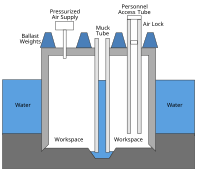Caisson (engineering)

A caisson is like a giant box that is used to build things underwater. Imagine you want to build a big building next to a river or on an island that is surrounded by water. You need to dig down into the ground to make a hole so you can lay the building's foundation. But if the ground is waterlogged, then it's too hard to dig. That's where a caisson comes in handy.
First, engineers build a big metal box called a caisson, which can be as big as a house. Then they put it in the water and let it sink down to the bottom where they want to build. Once the caisson is in position, they pump out all the water inside the box so the space inside the box is empty. This means that the workers are now underground but they're not wet.
Next, the workers can start digging and building the foundation in the caisson box. They can use a crane to lower equipment and materials into the caisson. Once the foundation is built, the workers can fill in the gap between the walls of the caisson and the sides of the hole with concrete or dirt to make it strong and secure. Finally, they can build the rest of the building on top of the foundation.
Overall, a caisson makes it possible to build structures underwater, like bridges or skyscrapers, in a safe and effective way. It's like a big underwater building site that keeps the workers dry and allows them to do their jobs.
First, engineers build a big metal box called a caisson, which can be as big as a house. Then they put it in the water and let it sink down to the bottom where they want to build. Once the caisson is in position, they pump out all the water inside the box so the space inside the box is empty. This means that the workers are now underground but they're not wet.
Next, the workers can start digging and building the foundation in the caisson box. They can use a crane to lower equipment and materials into the caisson. Once the foundation is built, the workers can fill in the gap between the walls of the caisson and the sides of the hole with concrete or dirt to make it strong and secure. Finally, they can build the rest of the building on top of the foundation.
Overall, a caisson makes it possible to build structures underwater, like bridges or skyscrapers, in a safe and effective way. It's like a big underwater building site that keeps the workers dry and allows them to do their jobs.
Related topics others have asked about:
